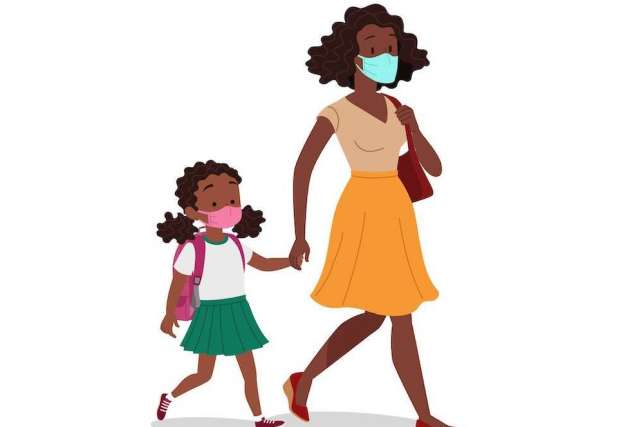COVID-19 has disproportionately burdened low-income families, especially low-income communities of color, across the country – from economic losses to death rates to educational setbacks, studies show. Material hardship and psychological distress were exacerbated for low-income families, according to a 2020 Urban Institute study, which warned such stress can have long-lasting impacts on children.
When children return to classrooms this fall, schools must consider how they’ll provide additional support to the students who lacked the resources of their wealthier peers to maintain learning progress through pandemic-driven closures.
A Los Angeles Times survey of 45 Southern California school districts found that the pandemic magnified and deepened the racial and socioeconomic systemic inequities these children and their families already faced:
- The already-existing digital divide widened due to lack of tech equipment and broadband internet at home;
- Parents with essential jobs struggled to find consistent childcare and oversee their children’s work while also paying for food and housing;
- Miscellaneous support services provided by the school – such as access to reduced-price or free breakfasts and lunches – were much harder, if not impossible, to access.
Doctors and teachers who have trusted relationships with families can help equip children of low-resourced areas to return safely and successfully, say UCLA Health pediatricians Alice Kuo, MD, PhD, and Rebecca Dudovitz, MD, MSHS.
“You have kids of all ages, between kindergarten and 12th grade, who just lost an entire year of education,” Dr. Kuo says. “What we’ve seen in the past year is ample evidence to show that distance learning is not equivalent to in-person learning for the vast majority of children.”
“We have a really important role to play in helping families wrestle with the risks and benefits of being in-person at school,” says Dr. Dudovitz, associate professor of pediatrics at the UCLA David Geffen School of Medicine. “The goal is to get children back in school for a normal, typical school day.”
A digital divide
“What the pandemic brought into focus, through mandated remote learning, is the intimate connection between education and technological connectivity,” according to a report from the UCLA Center for Neighborhood Knowledge, which found more than two in five low-income households had only limited access to a computer or the internet.
According to a recent study from Rutgers University, though internet access among low-income families has increased since 2015, internet speed remains a barrier. Some families rely solely on cell phones to go online – which may present data limits.
Dr. Kuo, chief of Medicine-Pediatrics at UCLA Health, says she heard from some families that they didn’t always have enough electronic devices to go around.
“In lower-income families, putting food on the table is a priority and not every kid has a tablet,” Dr. Kuo says. “It took a while for school districts to get devices in the hands of families.”
Policymakers have recommended closing the digital gap by funding the expansion of and access to broadband networks and digital equipment, which may require “partnering across public, private and social sectors is needed to assess student-level needs and inform responses,” according to education nonprofit Common Sense.
“High-speed internet and reliable technology is critical to being able to participate well in school,” says Dr. Dudovitz, director of Pediatric Health Services Research. “We know many families struggled to have those basic needs met.”
For now, having students return to in-person learning may help to begin reducing the gap. Citing the widening inequities, the American Academy of Pediatrics (AAP) has offered guidance encouraging doctors recommend a return to in-person learning: “Pediatricians should emphasize a layered approach that prioritizes attending school in person, while protecting students and staff from SARS-CoV-2 variants that may be more transmissible.”
Returning to classrooms
Drs. Kuo and Dudovitz say the most important strategy for students to safely return to classrooms is to boost vaccination rates, which have been lower in under-resourced, communities of color.
“The more we’re learning and tracking these numbers, we realize it’s both an issue of access and trust and being ready to get the vaccine,” Dr. Dudovitz says. “This is an area, as pediatricians, we are very experienced in. We talk to families about decisions around vaccines basically every day.
“What’s really important is that we get as many folks vaccinated as possible because that’s the No. 1 way to keep you and your family safe.”
Once back in classrooms, some students may need more personalized attention and support from teachers to address any learning gaps stemming from a lack of resources, the pediatricians say.
That support, education experts say, may include re-establishing school routines and norms, providing emotional and mental health services and even incorporating into curriculums some of the skills learned during the year of remote learning, such as independent study and navigating a flexible schedule.
“Some children are feeling very nervous about going back into a world that is no longer socially distanced,” Dr. Dudovitz says. “Being able to express those feelings and have open conversations about that is probably the most important thing.”
Parents and caretakers can prepare children by helping them cope with one of the biggest challenges of the pandemic – all the change.
“All of us feel a little bit more confident when we know what to expect,” Dr. Dudovitz says. “When you do have information about what the school day is going to look like or what changes might be coming, it’s helpful to talk to your child so they can anticipate what their school day will be like.”
Ultimately, it’s important for parents, teachers and doctors “to continue to invest and shore up,” Dr. Kuo says, “because this is where our children are.”
More in this series:
Back to school: Weighing the pros and cons of remote learning
Back to school: LGBTQ+ students lost some support networks during the pandemic
Back to school: It’s almost time to return to the classroom – but is it safe?
Courtney Perkes is the author of this article.





